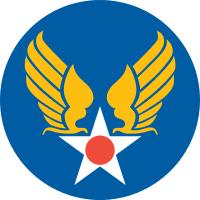Georgia World War II Army Airfields
| Georgia World War II Army Airfields |
|---|
|
Part of World War II |
|
|
| Type |
Army Airfields |
|---|
| Site history |
|---|
| Built |
1940-1944 |
|---|
| In use |
1940--present |
|---|
During World War II, the United States Army Air Forces (USAAF) established numerous airfields in Georgia for antisubmarine defense in the Gulf of Mexico and for training pilots and aircrews of USAAF fighters and bombers.
Most of these airfields were under the command of Third Air Force or the Army Air Forces Training Command (AAFTC) (A predecessor of the current-day United States Air Force Air Education and Training Command). However the other USAAF support commands (Air Technical Service Command (ATSC); Air Transport Command (ATC) or Troop Carrier Command) commanded a significant number of airfields in a support roles.
It is still possible to find remnants of these wartime airfields. Many were converted into municipal airports, some were returned to agriculture and several were retained as United States Air Force installations and were front-line bases during the Cold War. Hundreds of the temporary buildings that were used survive today, and are being used for other purposes.
Major airfields
First Air Force
- Chatham Army Airfield, 6.7 miles (10.8 km) west-northwest of Savannah
- 425th Army Air Force Base Unit
- Sub-base of: Jacksonville Army Airfield, Florida
- Also used by: Army Air Forces Antisubmarine Command (1942-1943)
- Transferred to: Third Air Force (1945)
- Was: Chatham Air Force Base (1947-1950)
- Now:
 Savannah Air National Guard Base (IATA: SAV, ICAO: KSAV, FAA LID: SAV)
Savannah Air National Guard Base (IATA: SAV, ICAO: KSAV, FAA LID: SAV)
- Harris Neck Army Airfield, 32.7 miles (52.6 km) south-southwest of Savannah
- 346th Army Air Force Base Unit (Replacement Training Unit, Fighter),
- Sub-base of: Dale Mabry Field, Florida
- Transferred to: United States Navy (1945)
- Now: Harris Neck National Wildlife Refuge
Third Air Force
- Statesboro Army Airfield, 3.6 miles (5.8 km) northeast of Statesboro
- Sub-base of: Morris Field. North Carolina, later William Northern Field, Tennessee
- 343d Army Air Force Base Unit
- Now: Statesboro-Bulloch County Airport (IATA: TBR, ICAO: KTBR, FAA LID: TBR)
- Thomasville Army Airfield, 7.4 miles (11.9 km) northeast of Thomasville
- 42d Army Air Force Base Unit
- Now: Thomasville Regional Airport (IATA: TVI, ICAO: KTVI, FAA LID: TVI)
|
- Hunter Field, 5.7 miles (9.2 km) south-southwest of Savannah
- 36th Army Air Force Base Unit
- Also used by: Army Air Forces Antisubmarine Command (1942-1943)
- Was: Hunter Air Force Base (1950-1967)
- Now:
 Hunter Army Airfield (United States Army) (IATA: SVN, ICAO: KSVN, FAA LID: SVN) Hunter Army Airfield (United States Army) (IATA: SVN, ICAO: KSVN, FAA LID: SVN)
- Waycross Army Airfield, 3.5 miles (5.6 km) northwest of Waycross
- 531st Army Air Force Base Unit
- Sub-base of: Hunter Field, later Drew Field, Florida
- Now: Waycross-Ware County Airport (IATA: AYS, ICAO: KAYS, FAA LID: AYS)
|
AAF Training Command
Eastern Flight Training Center
- Bainbridge Army Airfield, 6.0 miles (9.7 km) northwest of Bainbridge
- Army Air Forces Pilot School (Advanced Single-Engine)
- 3305th Pilot Training Group (Contract Primary)
- 332d Army Air Force Base Unit
- Known sub-bases and auxiliaries
- Donalsonville Auxiliary Field
- Reynoldville Auxiliary Field
- Faceville Auxiliary Field
- Vada Auxiliary Field
- Babcock Auxiliary Field
- Commodore Decatur Auxiliary Field
- Later: Bainbridge Air Base (1951-1961)
- 3306th Pilot Training Group (Contract Flying)
- Now: Decatur County Industrial Air Park (IATA: BGE, ICAO: KBGE, FAA LID: BGE)
- Army Air Force Pilot School (Basic)
- Royal Air Force Cadet training
- 27th Flying Training Wing
- 61st Army Air Force Base Unit
- Known sub-bases and auxiliaries
- Gunn Auxiliary Field
- Perry Auxiliary Field
- Harris Auxiliary Field
- Byron Auxiliary Field
- Myrtle Auxiliary Field
- Now: Middle Georgia Regional Airport (IATA: MCN, ICAO: KMCN, FAA LID: MCN)
- Moody Field, 10.6 miles (17.1 km) north-northeast of Valdosta
- Army Air Force Pilot School (Primary)
- 29th Flying Training Wing
- 78th Army Air Force Base Unit
- Known sub-bases and auxiliaries
- Rock Ford Auxiliary Field
- Lake Park Auxiliary Field
- Bemiss Auxiliary Field
- New River Auxiliary Field
- Valdosta Auxiliary Field
- Now:
 Moody Air Force Base (IATA: VAD, ICAO: KVAD, FAA LID: VAD) Moody Air Force Base (IATA: VAD, ICAO: KVAD, FAA LID: VAD)
|
- Spence Field, 5.8 miles (9.3 km) east-southeast of Moultrie
- Army Air Forces Pilot School (Advanced Single-Engine)
- 75th Army Air Force Base Unit
- Known sub-bases and auxiliaries
- Berlin Auxiliary Field
- Norman Park Auxiliary Field
- Moultrie Municipal Airport
- Tifton Municipal Airport
- Later: Spence Air Base (1951-1961)
- 3302d Flying Training Squadron (Contract Flying)
- Now: Spence Airport (IATA: MUL, ICAO: KMUL, FAA LID: MUL)
- Army Air Forces Pilot School (Advanced Twin-Engine)
- 74th Flying Training Wing
- 75th Army Air Force Base Unit
- Known sub-bases and auxiliaries
- Leesburg Auxiliary Field
- West Smithville Auxiliary Field
- West Leesburg Auxiliary Field
- North Smithville Auxiliary Field
- Cordale Municipal Airport
- Vidalia-Lyons Auxiliary Field
- Tifton Municipal Airport
- Albany Army Airfield
- Later: Turner Air Force Base (1947-1967)
- Later: Naval Air Station Albany (1967-1976)
- Now: Non-Aviation Use (Industrial Area)
|
AAF Contract Flying Schools
- Albany Army Airfield, 3.7 miles (6.0 km) northwest of Albany
- Contract Flying School: Darr Aero Tech
- Also: Auxiliary to Turner Field
- 52nd Army Air Force Fight Training Detachment. (Primary)
- Known sub-bases and auxiliaries
- Hayley Auxiliary Field
- Reynolds Auxiliary Field
- River Auxiliary Field
- Turner Auxiliary Field
- Now: Southwest Georgia Regional Airport (IATA: ABY, ICAO: KABY, FAA LID: ABY)
- Bush Field, 7.1 miles (11.4 km) south of Augusta
- Contract Flying School: Georgia Aero Tech
- 72d Army Air Force Flight training Detachment (Basic)
- Known sub-bases and auxiliaries
- Dionne Auxiliary Field
- Yawn Auxiliary Field
- Now: Augusta Regional Airport (IATA: AGS, ICAO: KAGS, FAA LID: AGS)
|
- South Georgia College Civil Pilot Training School (Primary)
- 63d Flight Training Detachment
- Known sub-bases and auxiliaries
- Tanner-Ewing Auxiliary Field
- Knight Auxiliary Field
- Dorminey Auxiliary Field
- Paulk Auxiliary Field
- Now: Douglas Municipal Airport (ICAO: KDQH, FAA LID: DQH)
- Souther Civil Pilot Training School (Primary)
- 56th AAF Flying Training Detachment
- Now: Jimmy Carter Regional Airport (ICAO: KACJ, FAA LID: ACJ)
|
Air Technical Service Command
- 303d Army Air Force Base Unit
- Warner Robins Air Service Command (WRASC)
- USAAF/Civil Airfield Joint Use
- Also used by: United States Navy
- Now: Hartsfield-Jackson Atlanta International Airport (IATA: ATL, ICAO: KATL, FAA LID: ATL)
- Daniel Army Airfield, 4.4 miles (7.1 km) west of Augusta
- 387th Air Service Group
- 21st Army Air Force Base Unit
- Warner Robins Air Service Command (WRASC)
- Also used by Third Air Force (1941-1942)
- Joint use USAAF/Civil Airfield
- Also used by: Army Air Forces Antisubmarine Command (1942-1943)
- Now: Daniel Field (IATA: DNL, ICAO: KDNL, FAA LID: DNL)
- Macon Army Air Base, 4.3 miles (6.9 km) west of Macon
- 37th Air Depot Group
- 469th Army Air Force Base Unit
- Warner Robins Air Service Command (WRASC)
- USAAF/Civil Airfield Joint Use
- Now: Macon Downtown Airport (IATA: MAC, ICAO: KMAC, FAA LID: MAC)
|
- Marietta Army Airfield, 13.7 miles (22.0 km) north-northwest of Atlanta
- 292d Army Air Force Base Unit
- Bell Aircraft B-29 Superfortress Manufacturing/Delivery
- Also used by: Second Air Force
- Now:
 Dobbins Joint Air Reserve Base (IATA: MGE, ICAO: KMGE, FAA LID: MGE) Dobbins Joint Air Reserve Base (IATA: MGE, ICAO: KMGE, FAA LID: MGE)
- Robins Field, 1.4 miles (2.3 km) north-northeast of Warner Robins
- 4117th Army Air Force Base Unit
- Warner Robins Air Service Command (WRASC)
- Warner Robins Air Depot
- Now:
 Robins Air Force Base (IATA: WRB, ICAO: KWRB) Robins Air Force Base (IATA: WRB, ICAO: KWRB)
- And:
 Warner Robins Air Logistics Center (WRALC) Warner Robins Air Logistics Center (WRALC)
|
Minor Airfields
References
 This article incorporates public domain material from websites or documents of the Air Force Historical Research Agency.
This article incorporates public domain material from websites or documents of the Air Force Historical Research Agency.
- Manning, Thomas A. (2005), History of Air Education and Training Command, 1942-2002. Office of History and Research, Headquarters, AETC, Randolph AFB, Texas ASIN: B000NYX3PC
- Maurer, Maurer (1983). Air Force Combat Units Of World War II. Maxwell AFB, Alabama: Office of Air Force History. ISBN 0-89201-092-4.
- Ravenstein, Charles A. (1984). Air Force Combat Wings Lineage and Honors Histories 1947-1977. Maxwell AFB, Alabama: Office of Air Force History. ISBN 0-912799-12-9.
- Thole, Lou (1999), Forgotten Fields of America : World War II Bases and Training, Then and Now - Vol. 2. Pictorial Histories Pub . ISBN 1-57510-051-7
- Military Airfields in World War II - Georgia
External links
|
|---|
| | Airfields |
- First Air Force Group Training Stations
- First Air Force Replacement Training Stations
- First Air Force Tactical Airfields
| |
|---|
| | Units | Commands | |
|---|
| Wings | |
|---|
| Groups | Bombardment | |
|---|
| Combat Cargo | |
|---|
| Fighter | |
|---|
| Reconnaissance | |
|---|
| Troop Carrier | |
|---|
| Other | |
|---|
|
|---|
|
|---|
|
- United States Army Air Forces
|
|
|
|---|
| | Airfields |
- Group Training Stations
- Replacement Training Stations
- Tactical Airfields
| |
|---|
| | Units | Commands | |
|---|
| Divisions | |
|---|
| Wings | |
|---|
| Groups | Air Commando |
- 2nd Air Commando
- 3rd Air Commando
|
|---|
| Bombardment | |
|---|
| Fighter | |
|---|
| Fighter-Bomber | |
|---|
| Reconnaissance | |
|---|
|
|---|
|
|---|
|
- United States Army Air Forces
|
|
|
|---|
| | Flying Training | Flying Schools | |
|---|
| Specialized Schools | |
|---|
| |
|---|
| | Technical Training |
- Eastern Technical Training Command
- Central Technical Training Command
- Western Technical Training Command
|
|---|
|


 Savannah Air National Guard Base (IATA: SAV, ICAO: KSAV, FAA LID: SAV)
Savannah Air National Guard Base (IATA: SAV, ICAO: KSAV, FAA LID: SAV)![]() This article incorporates public domain material from websites or documents of the Air Force Historical Research Agency.
This article incorporates public domain material from websites or documents of the Air Force Historical Research Agency..jpg)
.svg.png)
